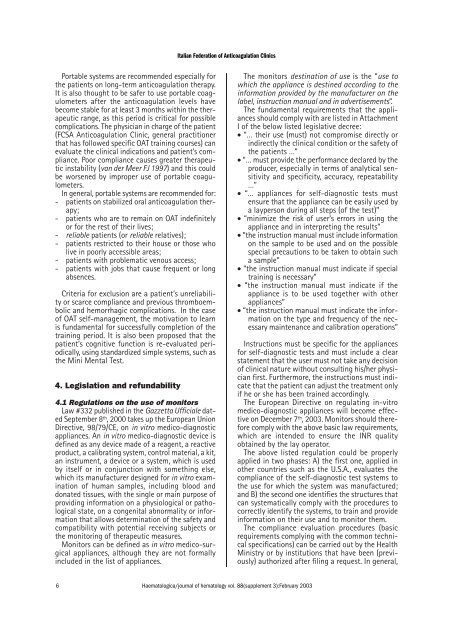Haematologica 2003 - Supplements - Haematologica
Haematologica 2003 - Supplements - Haematologica
Haematologica 2003 - Supplements - Haematologica
You also want an ePaper? Increase the reach of your titles
YUMPU automatically turns print PDFs into web optimized ePapers that Google loves.
Italian Federation of Anticoagulation ClinicsPortable systems are recommended especially forthe patients on long-term anticoagulation therapy.It is also thought to be safer to use portable coagulometersafter the anticoagulation levels havebecome stable for at least 3 months within the therapeuticrange, as this period is critical for possiblecomplications. The physician in charge of the patient(FCSA Anticoagulation Clinic, general practitionerthat has followed specific OAT training courses) canevaluate the clinical indications and patient’s compliance.Poor compliance causes greater therapeuticinstability (van der Meer FJ 1997) and this couldbe worsened by improper use of portable coagulometers.In general, portable systems are recommended for:- patients on stabilized oral anticoagulation therapy;- patients who are to remain on OAT indefinitelyor for the rest of their lives;- reliable patients (or reliable relatives);- patients restricted to their house or those wholive in poorly accessible areas;- patients with problematic venous access;- patients with jobs that cause frequent or longabsences.Criteria for exclusion are a patient’s unreliabilityor scarce compliance and previous thromboembolicand hemorrhagic complications. In the caseof OAT self-management, the motivation to learnis fundamental for successfully completion of thetraining period. It is also been proposed that thepatient’s cognitive function is re-evaluated periodically,using standardized simple systems, such asthe Mini Mental Test.4. Legislation and refundability4.1 Regulations on the use of monitorsLaw #332 published in the Gazzetta Ufficiale datedSeptember 8 th , 2000 takes up the European UnionDirective, 98/79/CE, on in vitro medico-diagnosticappliances. An in vitro medico-diagnostic device isdefined as any device made of a reagent, a reactiveproduct, a calibrating system, control material, a kit,an instrument, a device or a system, which is usedby itself or in conjunction with something else,which its manufacturer designed for in vitro examinationof human samples, including blood anddonated tissues, with the single or main purpose ofproviding information on a physiological or pathologicalstate, on a congenital abnormality or informationthat allows determination of the safety andcompatibility with potential receiving subjects orthe monitoring of therapeutic measures.Monitors can be defined as in vitro medico-surgicalappliances, although they are not formallyincluded in the list of appliances.The monitors destination of use is the “use towhich the appliance is destined according to theinformation provided by the manufacturer on thelabel, instruction manual and in advertisements“.The fundamental requirements that the appliancesshould comply with are listed in AttachmentI of the below listed legislative decree:• “… their use (must) not compromise directly orindirectly the clinical condition or the safety ofthe patients …”• “… must provide the performance declared by theproducer, especially in terms of analytical sensitivityand specificity, accuracy, repeatability…”• “… appliances for self-diagnostic tests mustensure that the appliance can be easily used bya layperson during all steps (of the test)”• “minimize the risk of user’s errors in using theappliance and in interpreting the results”• “the instruction manual must include informationon the sample to be used and on the possiblespecial precautions to be taken to obtain sucha sample”• “the instruction manual must indicate if specialtraining is necessary”• “the instruction manual must indicate if theappliance is to be used together with otherappliances”• “the instruction manual must indicate the informationon the type and frequency of the necessarymaintenance and calibration operations”Instructions must be specific for the appliancesfor self-diagnostic tests and must include a clearstatement that the user must not take any decisionof clinical nature without consulting his/her physicianfirst. Furthermore, the instructions must indicatethat the patient can adjust the treatment onlyif he or she has been trained accordingly.The European Directive on regulating in-vitromedico-diagnostic appliances will become effectiveon December 7 th , <strong>2003</strong>. Monitors should thereforecomply with the above basic law requirements,which are intended to ensure the INR qualityobtained by the lay operator.The above listed regulation could be properlyapplied in two phases: A) the first one, applied inother countries such as the U.S.A., evaluates thecompliance of the self-diagnostic test systems tothe use for which the system was manufactured;and B) the second one identifies the structures thatcan systematically comply with the procedures tocorrectly identify the systems, to train and provideinformation on their use and to monitor them.The compliance evaluation procedures (basicrequirements complying with the common technicalspecifications) can be carried out by the HealthMinistry or by institutions that have been (previously)authorized after filing a request. In general,6 <strong>Haematologica</strong>/journal of hematology vol. 88(supplement 3):February <strong>2003</strong>
















